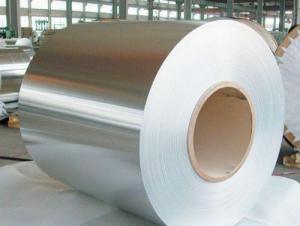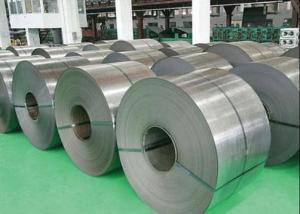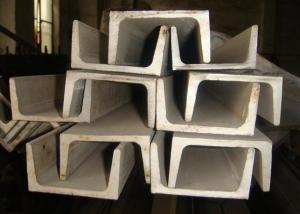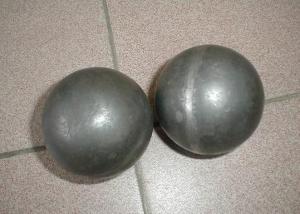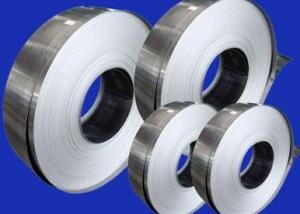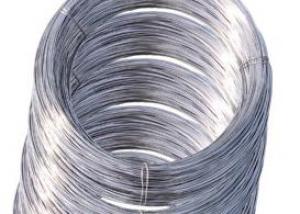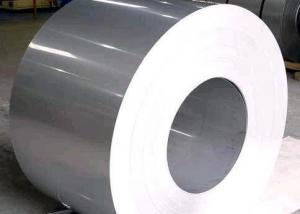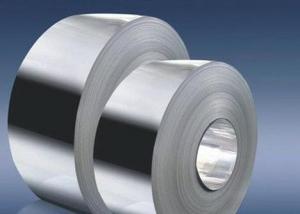Stainless Steel Coil
- Loading Port:
- China Main Port
- Payment Terms:
- TT or L/C
- Min Order Qty:
- 1 MT m.t.
- Supply Capability:
- 3500MT Per Month m.t./month
OKorder Service Pledge
Quality Product, Order Online Tracking, Timely Delivery
OKorder Financial Service
Credit Rating, Credit Services, Credit Purchasing
You Might Also Like
- Q:Can stainless steel wire be used for wire sculptures?
- Yes, stainless steel wire can definitely be used for wire sculptures. It is a popular choice for sculptors due to its durability, strength, and resistance to corrosion. Additionally, stainless steel wire offers flexibility and can be easily manipulated into various shapes and forms, making it ideal for creating intricate and detailed sculptures.
- Q:What are the different types of stainless steel wire coatings for corrosion resistance?
- To enhance corrosion resistance, stainless steel wire can be coated with various types of coatings. Some commonly used coatings include: 1. Electroplating: By immersing the wire in an electrolyte solution and passing an electric current through it, a thin layer of metal like zinc or nickel is deposited on the wire's surface. This extra layer acts as a protective barrier against corrosion. 2. Hot-dip galvanizing: This method involves immersing the wire in molten zinc, creating a thick and durable coating. It provides excellent corrosion resistance, even in harsh environments and is commonly used for wire products exposed to moisture or corrosive substances. 3. Polymer coatings: Different types of polymer coatings, such as PVC, polyethylene, or epoxy, can be applied to stainless steel wire to prevent corrosion. These coatings are usually applied through extrusion or dip coating processes. They offer good resistance to chemicals and environmental factors, making them suitable for various applications. 4. Passivation: Passivation is a chemical treatment that removes free iron or iron oxide from the wire's surface, creating a passive layer that prevents corrosion. Nitric acid or citric acid can be used for this process, followed by rinsing and drying to ensure proper corrosion resistance. 5. Powder coating: Dry powder is applied to the wire and then heated to form a tough and protective film. This method provides excellent resistance to corrosion, impact, and abrasion. Powder coatings are available in various colors and finishes, making them popular for decorative wire applications. In summary, the choice of stainless steel wire coating for corrosion resistance depends on the intended use, required protection level, and environmental conditions. It is essential to consider these factors and consult experts or manufacturers to determine the most suitable coating for a specific situation.
- Q:What are the different types of stainless steel wire ropes used in automotive applications?
- There are various stainless steel wire ropes utilized in automotive applications, each possessing unique characteristics and serving specific purposes. 1. Construction of 1x19: This wire rope comprises 19 individual strands twisted together in a solitary layer. It is commonly utilized in applications necessitating high strength and limited flexibility, such as brake cables and suspension components. 2. Construction of 7x7: In this type of construction, the wire rope is formed by twisting together 7 individual strands, with each strand containing 7 wires. It offers a favorable balance between strength, flexibility, and durability, making it suitable for applications like throttle cables and control mechanisms. 3. Construction of 7x19: This wire rope consists of 7 strands, each comprising 19 wires, providing enhanced flexibility and easy manipulation. It is frequently employed in applications requiring both strength and flexibility, such as winch cables and towing ropes. 4. Construction of 6x19: In this construction, there are 6 strands, each containing 19 wires. It delivers improved flexibility and resistance to abrasion, making it appropriate for applications like lifting slings and hoisting cables. 5. Construction of 6x36: This wire rope is composed of 6 strands, with each strand consisting of 36 wires. It offers exceptional flexibility and resistance to fatigue, making it ideal for applications involving repetitive bending and flexing, such as crane ropes and wire rope slings. When selecting a stainless steel wire rope for automotive applications, it is crucial to consider factors such as strength, flexibility, durability, and resistance to corrosion and abrasion.
- Q:How can the stainless steel tube be made of silk?
- Stainless steel pipe is a kind of hollow long strip round steel, mainly used in petroleum, chemical, medical, food, light industry, machinery, instrument and other industrial pipeline and mechanical structure parts. In addition, the bending and torsional strength of the same weight is lighter, so it is also widely used in the manufacture of mechanical parts and engineering structures. It is also used to produce all kinds of conventional weapons, guns, shells and so on.
- Q:What are the different types of stainless steel wire springs used in the furniture industry?
- The furniture industry commonly employs various kinds of stainless steel wire springs to enhance support and functionality in different furniture pieces. Some of the stainless steel wire springs used in this industry include: 1. Coil Springs: These springs, which are widely utilized in furniture manufacturing, involve coiling stainless steel wire into a helical shape. They offer exceptional durability and support, making them suitable for a wide range of furniture applications. 2. Sinuous Springs: Also known as zigzag or serpentine springs, sinuous springs consist of a series of S-shaped wires fastened to the furniture frame. They are often employed in seating furniture, such as sofas and chairs, to provide a comfortable and supportive foundation. 3. Tension Springs: Referred to as extension springs as well, tension springs find typical use in recliners or furniture with adjustable features. These springs function by stretching or extending when force is applied and then returning to their original position upon release of the force. 4. Pocket Springs: Pocket springs, also known as encased or wrapped springs, consist of individually wrapped coil springs placed in fabric pockets. These springs are commonly found in high-end furniture pieces like mattresses and upholstered chairs, offering exceptional comfort and support. 5. Bonnell Springs: Hourglass-shaped coil springs, also called Bonnell springs, are large and interconnected. They are commonly employed in upholstered furniture like sofas and mattresses to provide consistent support and durability. 6. Torsion Springs: Torsion springs are generally used in furniture mechanisms that require rotational force or tension. They operate by exerting torque when twisted or rotated, making them suitable for applications like reclining chairs or adjustable headrests. Each type of stainless steel wire spring possesses unique characteristics and advantages, and the selection of the spring type depends on the specific requirements of the furniture piece and the desired level of comfort and support.
- Q:Is stainless steel wire suitable for wire knitting?
- Yes, stainless steel wire is suitable for wire knitting. It is durable, flexible, and resistant to rust and corrosion, making it a great choice for knitting intricate designs and creating sturdy and long-lasting wire knitted projects.
- Q:What are the common uses of stainless steel wire in the packaging industry?
- Stainless steel wire is widely used in the packaging industry due to its numerous beneficial properties. One of the common uses of stainless steel wire in packaging is for tying and securing packages. The wire is often used to bundle and tie together various items, such as boxes, cartons, and bags, ensuring that they remain tightly secured during transportation and storage. Another common use of stainless steel wire in packaging is for the production of wire mesh containers and shelves. These containers and shelves are commonly used in warehouses, factories, and retail environments to store and organize various packaged goods. Stainless steel wire mesh containers and shelves provide excellent durability and corrosion resistance, making them ideal for long-term use. Additionally, stainless steel wire is often utilized in the production of packaging machinery and equipment. It is commonly used in conveyor systems, where the wire is formed into belts or chains to transport packaged goods efficiently. The stainless steel wire's high strength and resistance to wear and tear make it a reliable choice for conveying heavy loads in the packaging industry. Moreover, stainless steel wire is also used for packaging-related accessories such as hooks, clips, and fasteners. These accessories are essential for securing packages and ensuring they are properly sealed. Stainless steel wire's strength and resistance to rust and corrosion make it an ideal material for these accessories, ensuring their longevity and effectiveness. Overall, stainless steel wire is a versatile material that finds several common uses in the packaging industry. From securing packages to manufacturing wire mesh containers and shelves, and even in the production of packaging machinery and accessories, stainless steel wire plays a vital role in ensuring the efficiency, durability, and safety of packaging operations.
- Q:Can stainless steel wire be used for making wire baskets?
- Yes, stainless steel wire can indeed be used for making wire baskets. Stainless steel is a popular choice for wire baskets due to its durability, corrosion resistance, and high strength-to-weight ratio. These properties make it ideal for applications where the basket needs to withstand heavy loads, exposure to moisture, and harsh environments. Additionally, stainless steel wire is easy to clean and maintain, making it suitable for use in various industries such as food processing, healthcare, and manufacturing. Its versatility and reliability make stainless steel wire a popular choice for making wire baskets.
- Q:What are the different manufacturing standards for stainless steel wire?
- There are several different manufacturing standards for stainless steel wire, which are established to ensure quality and consistency in the production process. Some of the most common standards include: 1. ASTM (American Society for Testing and Materials) standards: ASTM A580 and ASTM A313 are two widely used standards for stainless steel wire. ASTM A580 specifies the requirements for stainless steel wire, including chemical composition, mechanical properties, and dimensional tolerances. ASTM A313 specifically addresses stainless steel spring wire. 2. ISO (International Organization for Standardization) standards: ISO 9001 is a quality management system standard that applies to the manufacturing of stainless steel wire. ISO 9001 ensures that manufacturers follow a set of procedures to consistently deliver products that meet customer requirements. 3. EN (European Norm) standards: EN 10270-3 is a European standard that provides specifications for stainless steel wire for springs. It defines the requirements for chemical composition, mechanical properties, and surface quality. 4. JIS (Japanese Industrial Standards) standards: JIS G4314 is a Japanese standard that specifies stainless steel wire for springs. It covers the chemical composition, mechanical properties, and surface quality requirements. These standards help manufacturers in maintaining product consistency, ensuring the quality of stainless steel wire, and facilitating international trade by providing a common set of specifications. Compliance with these standards is essential to ensure that stainless steel wire meets the required performance criteria and can be used in a wide range of applications.
- Q:What does stainless steel wire drawing mean?
- Surface matte effect, mainly consider beautiful, elevator panels are drawing effect.
It is a comprehensive enterprise which specialized in melting of stainless steel, manufacturing of seamless steel pipes/tubes and stainless steel wire rod and sale.
Our products mainly contain stainless steel ingot, round steel, tube blank, parcel, finished pipes, wire rod, etc, which are of series 200 and series 300. We have most advanced equipment including 12-Ton intermediate frequency furnace, 15-Ton AOD Vessel, SPECTROMAX desk-top automatic spectrograph and ITON XLTXRF hand held type spectrogragh.
1. Manufacturer Overview |
|
|---|---|
| Location | Zhejiang, China |
| Year Established | 2005 |
| Annual Output Value | Above US$1.6 million |
| Main Markets | Europe, North America. |
| Company Certifications | |
2. Manufacturer Certificates |
|
|---|---|
| a) Certification Name | |
| Range | |
| Reference | |
| Validity Period | |
3. Manufacturer Capability |
|
|---|---|
| a)Trade Capacity | |
| Nearest Port | Shanghai |
| Export Percentage | 40% |
| No.of Employees in Trade Department | Above 30 people |
| Language Spoken: | English, Chinese |
| b)Factory Information | |
| Factory Size: | Above 5000 square meter |
| No. of Production Lines | Above 6 |
| Contract Manufacturing | OEM Service Offered |
| Product Price Range | Average |
Send your message to us
Stainless Steel Coil
- Loading Port:
- China Main Port
- Payment Terms:
- TT or L/C
- Min Order Qty:
- 1 MT m.t.
- Supply Capability:
- 3500MT Per Month m.t./month
OKorder Service Pledge
Quality Product, Order Online Tracking, Timely Delivery
OKorder Financial Service
Credit Rating, Credit Services, Credit Purchasing
Similar products
New products
Hot products
Hot Searches
Related keywords
